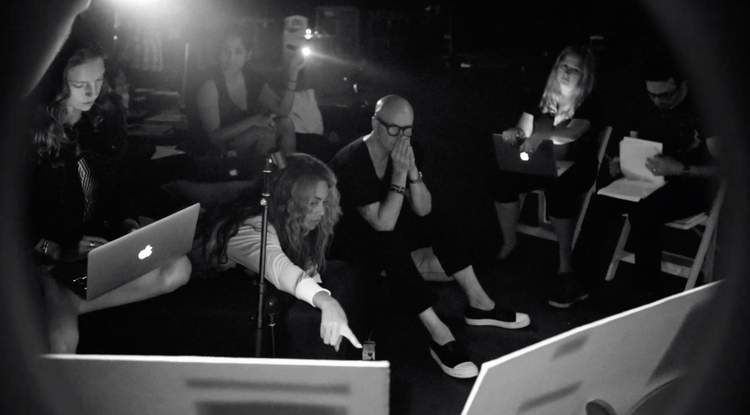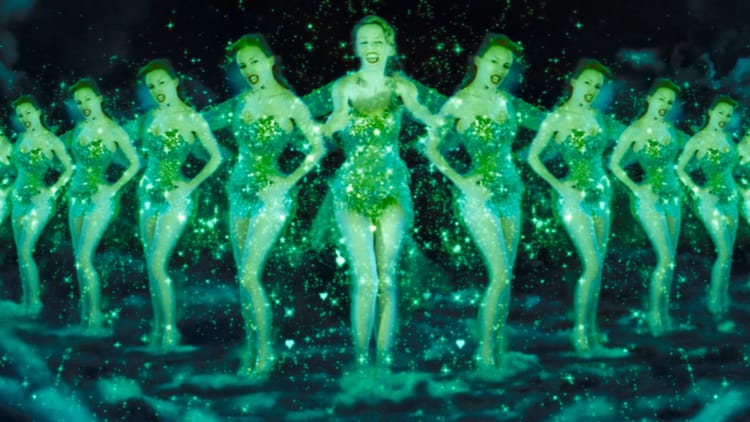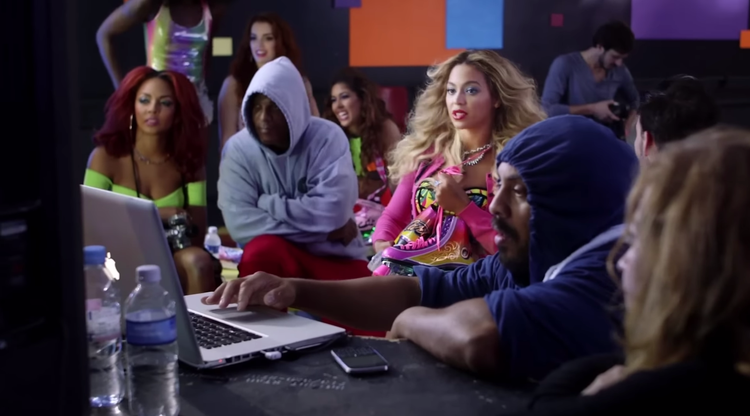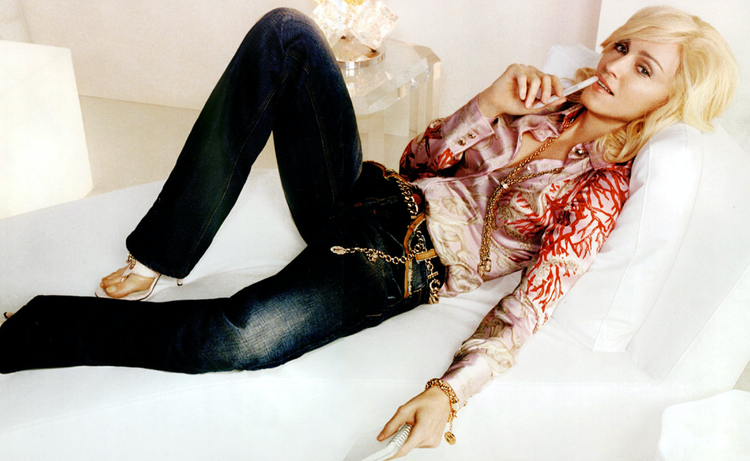Olivia & Elton & Dalida & Tina
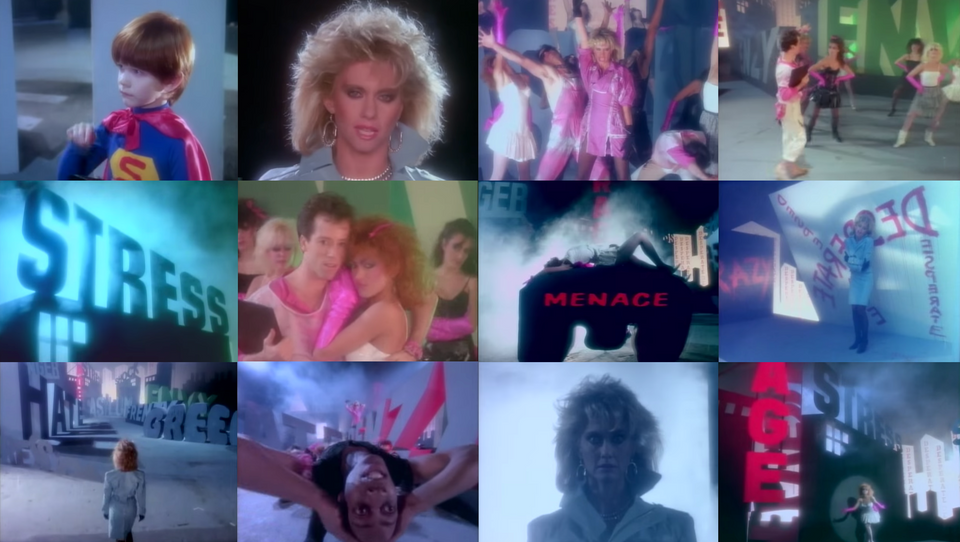
When I was in middle school, I had a dance teacher I liked a lot named Mr. Spain. (For the record: his full name is Timothy Spain, and it’s one he’s given me his blessing to use, but I frankly don’t think I can do it.) I was at this one school for six years, so even after he was no longer my dance teacher—I had three in total, all genuine highlights of my time there—I’d see him around in the halls, or waving into the studio from the shared dance teacher office.
At some point in my preteens, one of my friends pulled up Olivia Newton-John’s “(Livin’ in) Desperate Times” video on YouTube and pointed out Mr. Spain dancing in it. I thought the whole thing was funny—the video’s from 1983, and funny is probably the right word, though perhaps not the original intention—and realistically would’ve passed the info on to a couple other people, but that was that (though I did rip the MP3 file for my iPod, obviously). And, because I wasn’t yet invested at all in early MTV or even remotely aware of how the world worked, I assumed that it had been a random one-off in his career. The possibility that Mr. Spain hadn’t spent his entire adult life teaching at my school simply didn’t occur to me, and it wouldn’t have helped that, as far as my preteen brain understood things, he was playing a version of himself—teaching some sort of dystopian dance class—in the video.
A decade and a half later, by this point at least marginally smarter, I launched this newsletter and jotted Mr. Spain’s name down on a note somewhere, alongside all my other for-later ideas; maybe he’d one day want to speak with me about that one-off with Olivia Newton-John. It never felt like there was any urgency to follow through on it, but my hand was forced a bit when Olivia passed away last summer, following a decades-long battle with breast cancer. Envisioning a potential newsletter tribute to the visual album icon, I reached out to Mr. Spain sometime after her death.
And while our eventual conversation did shape up as such to some extent, I hadn’t realized—to my great shame, but I’m opting to fall on my sword here!—that the video was but a tiny sliver of a long and extensive commercial dance career, which was itself only a small piece of his resume. So, what follows is one of the more interesting interview experiences I’ve ever had, where I’m thrown curveball after curveball by a subject who doesn’t necessarily realize he’s throwing curveballs. (I’d be very curious to know whether you can read my panic through the screen!) We spoke in October during the run-up to my wedding, and the delay since has been us trying to fill any gaps as best as we could; there was some memory-correcting to do on his end, quite a bit of unfamiliar research terrain to explore on mine, and a hell of a lot of me scrubbing YouTube videos for glimpses of him—all of our joint findings appearing below. As for you, Mr. Spain, do consider writing that book!
So I was thinking about it this morning, and I would have been… I’m 26 now, and I would have been 11 when I met you, which I think is very funny. And I guess you’ve retired now but you’re still teaching.
I’m in the supply pool. It’s kind of like the mafia: you think you’re out…
But there’s too strong a grip.
Too strong a grip, yeah. But I’m in the supply pool, and it’s fun to go in and feel the buzz, see old friends, hang around sort of useful energy, and feel that enthusiasm, those aspirations. It’s bracing, so I like doing it.
And of course, when you’re in that setting—when you’re a middle-schooler—you don’t really know anything about your teachers and their personal lives or work histories unless your teacher has said something in class.
Yeah.
So when I was your student… I guess it was recent enough that I could have googled you, but if I ever did google you, I don’t remember doing it. So to me, you were just Mr. Spain. And I figured that you had some background in dance… and because I have a good memory, I do remember some of the songs that we’d warm up to in class. The year that I was your student, I did a dance to “New Soul” by Yael Naim, the Apple commercial song… another class did one to “Can’t Touch This.” And I remember we would warm up to “Release” by Justin Timberlake and Timbaland.
Oh right, those were… we’d do a number at the end of the course. We’d present.
Yeah! So you were clearly someone who liked pop music—not that that’s unusual for anyone, especially not a dance teacher.
Yeah, I mean I did start off in the classical world. I worked in ballet companies and was working in one in London, and I went over to Paris for the weekend, as one does, and sort of fell in love with the work of an American woman, Molly Molloy, who I’d actually met previously—I’d done some choreography with her. But she was teaching in Paris and someone said, “You’ve gotta come and do Molly’s class.” So I went and saw it, and it was an eye-opener. I was like, Whoa, that is the kind of dancing I want to do.
So I became a jazz dancer at that point, which doesn’t mean, like… *scats* It means contemporary, so anything to do with videos, commercials, musicals. I became a commercial dancer. And yeah, the music you train to is whatever’s hot. And clearly, when I started at your school, most of my students were in grade seven or eight for a long time, and that’s what they were interested in. You want to play music that’s gonna grab the kids, of course.
So I’ve obviously googled you now, and I feel silly because saying you had a background in dance doesn’t really do justice to your actual background and all the highlights. Maybe you could summarize, however briefly you’d like, your pre-teaching career. And I don’t want to let myself go off on too much of a tangent, but if you could try and remind me somehow to circle back to Toy Castle, I’ll have something to say.
You have been on Google, yeah. Well I started in the National Ballet system. I went to the school, and then joined the company. I started doing kids’ roles with them, because when I joined the school there were only three boys there at the time, and I was immediately thrown into this very exciting, modern production based on the Sophocles play [Electra], the one where Agamemnon comes back from the Trojan War and gets killed by his wife, Clytemnestra, and her lover, Aegisthus. And I’m the son, Orestes, and then later on I come back and kill my own mother. You know, Greek tragedy.
Yeah.
So I had that part, and then next thing I knew I was Fritz in The Nutcracker, I did all those kinds of things. And then I eventually joined the company down in Mexico, but that’s too long of a story to share with you now—that was a great experience. I guess I was 18, maybe 19.
So you were a National Ballet kid-turned-teenager-turned-adult.
Yeah, I’d been performing with them since I was 12 or 13, and I joined the company. And there was sort of a cultural revolution going on; those were the hippie years, and the years where there was a lot of iconoclastic action going on, and people breaking down institutions and getting them changed. But here I am in this incredibly staid establishment/institution… I mean, their whole raison d’être was to produce the classics. And I was part of a bunch of people who were saying, “No, c’mon, let’s do modern…” And there was some stuff, but not enough and not fast enough for a lot of us. And then eventually, after four years I had done too many Nutcrackers, and so I tried to get out.
Well, I did get out: we were on a tour to Europe, and I stayed rather than coming back. I told them beforehand that I wasn’t going to, but I stayed in Europe. And was running around auditioning, but I was not a great planner. I just showed up and thought, I’m a dancer, I’m gonna get work. And there were various offers, but none for right away. The only one I could get right away was—this was at the end of the summer when I’d used up all my savings, so suddenly I needed a job—and I got work with what was then called the Festival Ballet, it’s now known as the English National Ballet. So I’m basically back in the same kind of place doing Nutcracker again, you know? It was when I was working with them that I went over to Paris, and stayed there.
For ten years, I was doing commercial work, and I became a jazz dancer. And working in Paris was thrilling; it was a great time to be there and I did just about everything there is to do… cabaret… what they call music hall—Moulin Rouge, we’d call that a music hall. I was working mostly in one called Le Paradis Latin, which was an incredibly exciting place to work, and quite cutting-edge. And it’s this very Parisian mix of… feathers and froufrou and top hats and tails, but also some very biting numbers. And very political humour, topical stuff. But you’re in a big room of people eating and drinking, so you’re kind of competing with the food and the booze.
Right.
And it’s a very exciting environment to be in. The Paradis was started by a guy, Jean-Marie Rivière, who was a real potent, protean figure in French music hall, and he kind of renovated the form, brought it up to date. Because the Moulin Rouge was pretty much stuck in the Toulouse-Lautrec era. And for the first year, it was so exciting—there were artists, politicians, the whole crème de la crème of society was there; it was a thrilling place to be. I worked there on and off for four years, but I was doing TV work and a lot of variety work on television.
And then videos came in, so I started doing videos. I did a lot of videos with French people, like Dalida. She was a French-Italian-Egyptian woman who sadly is passed on now. But she was kind of the Madonna of France for a while, and she had a really big year. She had a hit called “Gigi in Paradisco” (1980). It was a real disco classic. She hired Lester Wilson, who was the choreographer who did… not all of Saturday Night Fever (1977), but the good parts. He was on a roll, too. And so I was in the show with her, which, again, was like being one of Madonna’s dancers and touring around and just having a total ball. And probably behaving in ways that I’m slightly ashamed of now, but you know, when you’re young you’re crazy—that’s the sort of thing you do.
Post-interview note: “Gigi in Paradisco” was the certified-gold title track from the 1980 album by Dalida, which originated out of a series of shows she’d done at Paris’s Palais des Sports, now the Dôme de Paris. “I worked with Dalida for a year or more,” Mr. Spain added later over email. “We toured all over France and in cities around the Mediterranean, but also did tons of TV specials on [the tour].” You can easily find him in virtually any video of the number on YouTube, including this one, and I also spotted him in this performance of Dalida’s 1979 hit “Monday Tuesday... Laissez moi danser.”
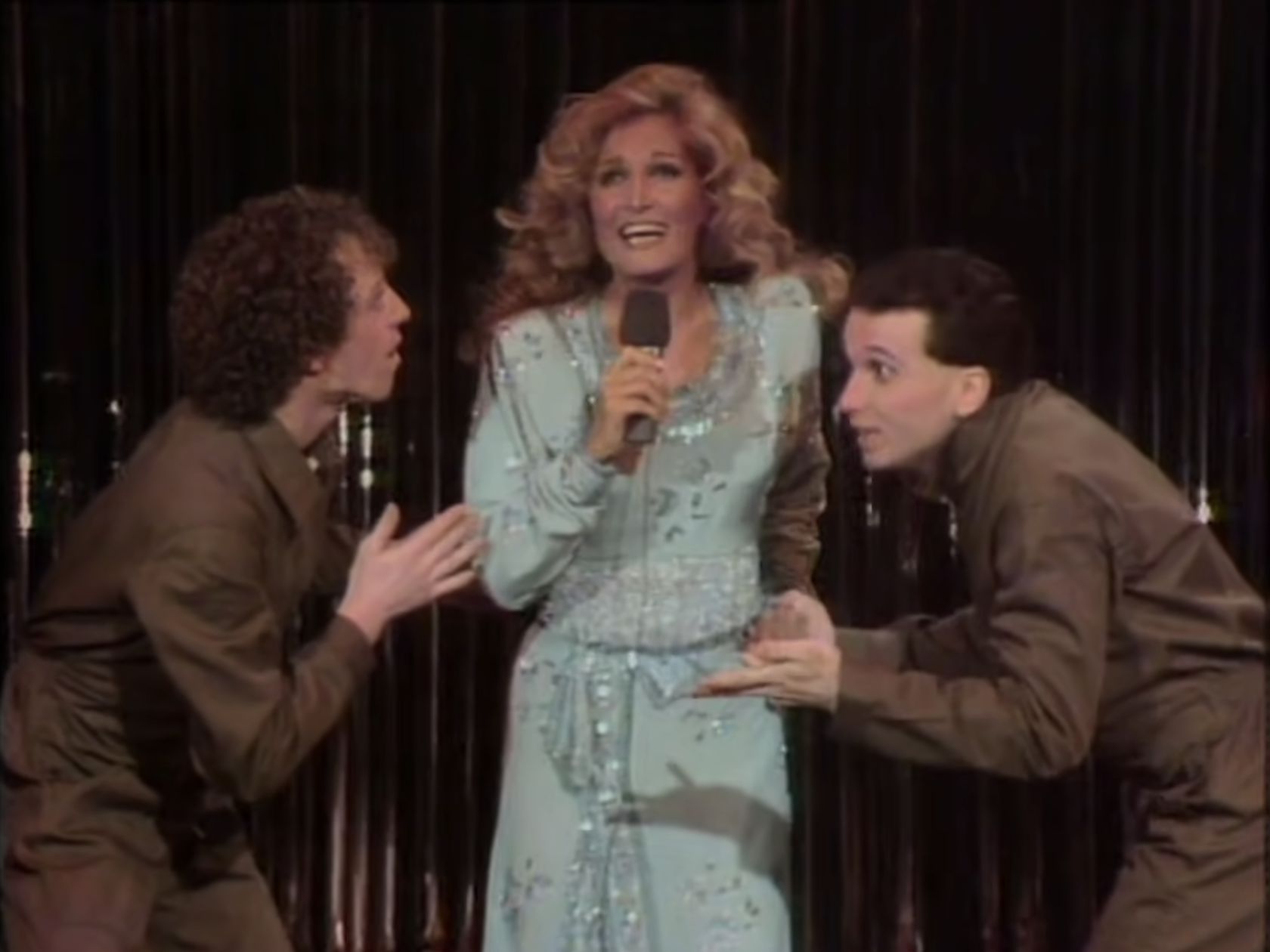
I did everything there was to do in Paris, including some serious concert work. I worked with a couple choreographers who were doing fine art work, or contemporary dance. But mostly I was working with Molly, who was a great choreographer, and she also had a company called the Molly Molloy Dance Theatre, so I was a founding member of that.
But then, after about ten years, I came back to London, where we were actually mounting a British version of the Paradis Latin show in the West End, in the Piccadilly Theatre. And unfortunately it didn’t take, because it’s a different culture: whereas the French, they have this several-hundred-year tradition of these kinds of music halls—people know what to expect—the British public, they like to sit in rows, and not eat and drink, and not talk.
Yeah.
And then in the intermission, go out and have lively conversation, and then go back in for the second half. And the French, they’re very extravagant; if they’re going to go out to one of these shows, it’s gonna cost a bundle. Whereas you’ve got the Brits going, “Is dinner included?” There was a lot of skepticism, and it just didn’t take. Anyway, the show only ran for about three quarters of a year or something, which is respectable but not great.
Then, I was doing a thing called The Hot Shoe Show.
Post-interview note: “The Hot Shoe Show” was a BBC variety dance/comedy program that aired from 1983 to 1984. As with “Gigi in Paradisco,” it was hard to find a video related to the show on YouTube that Mr. Spain wasn’t in—here’s a full episode, with the link set to him duetting with a fellow dancer to Billie Holiday’s “Don’t Explain.” (Arlene Phillips and Anthony Van Laast, two names you’ll hear a bit later in this interview, were also involved with the program.)
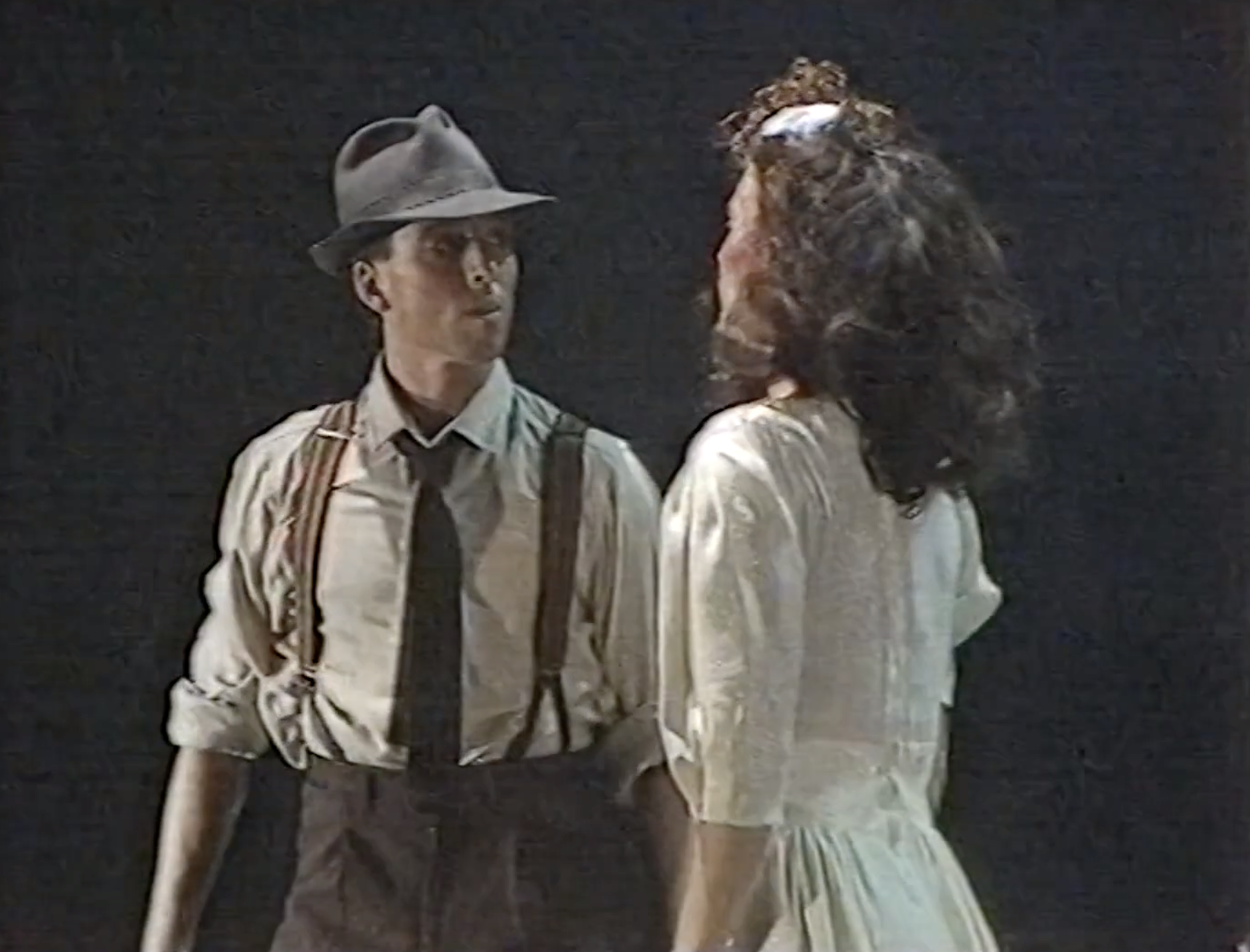
I did a lot of commercials in Paris and commercials in England when I came back… around ‘83. And I was doing different videos, including this one with Olivia Newton-John.
So in all of your background, I only knew of two things as a student, which were from other people telling me. One is silly, which was that you and a certain very famous Canadian dancer had dated at some point—that was told to me by a grade 12 student mentor. And the other was that you’d been in this Olivia Newton-John video. I imagine you must have shown it to a class at some point.
It came up. At that time, there was a lot of encouragement for the teachers who were teaching arts courses, they wanted you to have a career in the arts and share about it. And I gotta tell you, Sydney, of all the video work that I’d done, and I feel funny saying this… I have enormous admiration and respect for Olivia Newton-John, but it was like… the ‘80s, and just... dripping in cheese. I had done other stuff that I was much more proud of, and that was much more representative of my work as a dancer.
I wish I had a video of this piece that Molly choreographed to Bob Marley’s Exodus (1977), where I had a central role. That was a piece where, I’m just gonna say it, I was hot in that. And it was a really satisfying thing to do, but unfortunately we were using Bob Marley’s music—and he did come to see it!—and we could never film it. There were various bootleg things. But if you ask me, “What are you most proud of in your career?,” it would be dancing in Exodus.
And there were other videos that I did… Mireille Mathieu… Nana Mouskouri.
Post-interview note: I couldn’t find any videos of Mr. Spain’s work with Mireille Mathieu, but he did pop up a couple of times in my searches for Nana Mouskouri—in this performance of “Bougeotte Boogie” from 1981, and in this one of “Siko Chorepse Sirtaki” from the year prior (assuming the respective YouTube uploaders got their dates correct).
So in other words, music videos were a bedrock of how you were making a living at the time.
Yep.
Is it fair to say that of that work, this [Olivia Newton-John] video is maybe the most high-profile?
Well, no. Because I did one with Elton John…
Okay!
…which was a beautiful song, “Passengers,” after he’d been to South Africa and had been hanging out in the townships. *sings the chorus as Elton* It wasn’t a commercial hit, but I was working on that video and was the assistant choreographer because the same choreographer who did “(Livin’ in) Desperate Times,” who I’d known because I’d danced with her—her name was Arlene Phillips—she was choreographing the Elton John thing. It was filmed in Saint Tropez because I’d been living in France. She wanted me to be her assistant and help translate, and that was a fantastic shoot. I would show that [in class], and proudly.
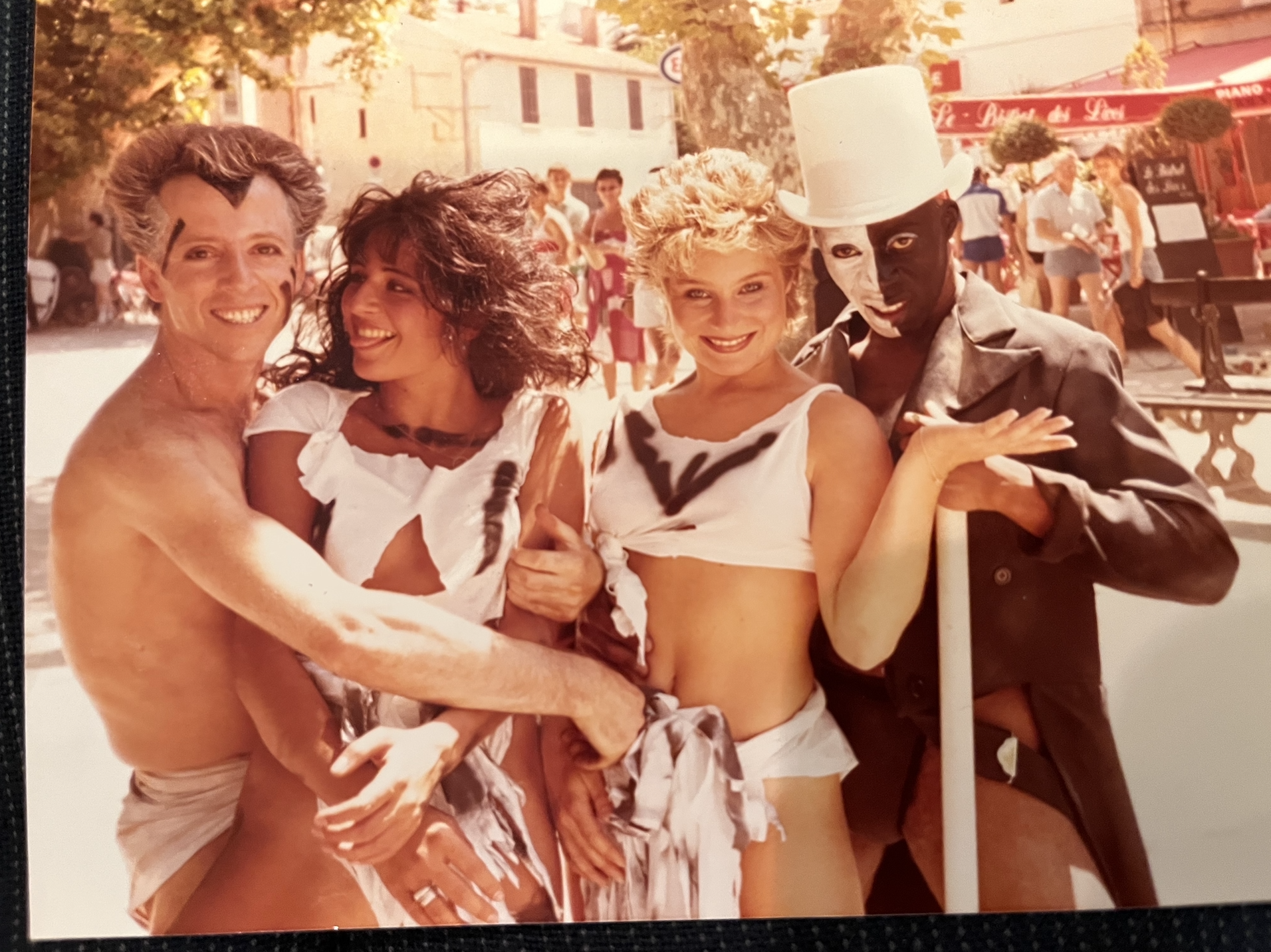
So Arlene Phillips, is that how you would have gotten the Olivia Newton-John job?
Yeah, though I did audition. She got the gig with Olivia, who was a massive star, and there were a whole lot of people involved. When the audition happened, there was a row of people sitting behind the table with clipboards. I knew that Arlene was on my side, and she wanted me to be there.
Tell me what you remember of the shoot. I think it was filmed in ‘83 because it was part of a video album Olivia released. So depending on whether you got the video album or waited for the single to come out, you either saw it in ‘83 or ‘84. And it was a modest chart hit; it reached #31 on the Billboard Hot 100, so that’s a song people were listening to.
Right… it wasn’t “Physical,” it wasn’t “Xanadu”—I think “modest” is a fair assessment of it. But it was a good song. When you and I got in touch, I went back and listened to it again, and what a great singer. Of course, when she passed away… I think I was driving when it came on that she’d died. It was great to be around her and she was an incredibly bright, affable, welcoming presence. She had a lot of people around her, but she was definitely somebody who… she was there on the set, this was a production we were all in. We were as valuable to her as anything. Because I didn’t know that much about her on a personal level, everything I knew up to that point had to do with her previous work… Grease (1978)…
Of course. And at this point, she’s not just Olivia Newton-John in a post-Grease, post-Xanadu (1980) world, she’s also Olivia Newton-John the massive MTV star. Because this is after Physical, and that song, that video.
Massive. Huge star. But here’s the deal. In my mind… I was talking earlier about the Paradis Latin. One thing they used to do occasionally was have [corporate] shows. A company that wanted to celebrate their year would rent us out for the night. And one time, we had Polydor Records; they’d had a huge year because they’d had Grease and they’d had the Who—they’d had a couple of really enormous things. So they hired us, and they wanted us to tailor the show for them. We did “You’re the One that I Want,” and I got to play Danny, and one of the gals played Sandy. But then we were allowed to keep that number in our repertoire, and it was very popular.
So for about a year, I’m doing, *John Travolta voice* “SANDY?” And so I sort of felt like I had this connection, somehow, with that character, and with Olivia Newton-John. But in my mind, she was Sandy. So I’m seeing her as this very sort of prim, wholesome gal that you’d take to meet your parents, who maybe on occasional weekends would get a little slinky, put on some black leather. But she was definitely, in my mind… I’m trying to find a way to say this that doesn’t get me in trouble. She was not like a…
Her star persona was that she was very attractive, very talented, but she herself would use the term “goody-goody.”
She’s not Rihanna, or Madonna, or anybody like that.
It wasn’t her thing.
It wasn’t her thing. And even when she did “Physical,” there was something sort of ironic… I don’t know if ironic is the right word. She was a proper, wholesome goody-goody. So I had that picture of her in my mind, and also, if I visualize her, it would probably be Sandy pre-black leather. So where am I going with this? I meet her, and I’ve got a couple of scenes where I’m interacting with her, chatting with her. But one day, I showed up to the studio—this was Pinewood Studios.
So you were in London.
Yeah, outside London, big complex of studios. And I happened to show up just when she was pulling up, in this big, honking, American-style limo. Really a real limo. And it was like a scene from a movie: she had various peeps with her, they kind of spilled out. And then this elegant foot comes out with the high heel. And up stands Olivia Newton-John, she’s got a fur coat on. It might have been false, I don’t know.
She was a big animal rights person, so maybe.
But I’m telling you, it was luxurious. She’s got pearls, she’s got sunglasses. She says, *Australian accent* “Hello, Tim.” And I’m going, She is like a grown-up lady. She was this glamorous, glamorous lady getting out of a limousine. And I’d thought she’d be showing up on a Vespa in her cardigan.
Because personality-wise, she was down to earth.
Personality-wise, she was Vespa girl. And really talking to you—she wanted to know about your life and what you’re doing. And another thing I remember was that Sting and the boys, the Police, were shooting a video in the next studio over. And there was quite a lot of excitement among us, and especially some of the girls: “Oh my God, Sting, oh my God.” And Olivia was very, “Oh yes, he’s so dishy, isn’t he?” Just joining in on that part of the conversation. She wasn’t going to gawk at him—for all I know, she went for drinks with him—but she was participating in that sort of fun with the girl dancers. We were all salivating over Sting.
Post-interview note: I’m almost positive that the Police video in question was “Synchronicity II,” filmed at Shepperton Studios in 1983.
That’s funny. You’ve probably seen it, but on YouTube there’s this four- or five-minute making-of clip—it’s from British TV. And there’s this funny undertone that she was doing something pretty wildly different in terms of her image. The song is referred to as “an aggressive song with undertones of fear and violence,” and that’s where I pulled “goody-goody” from, because she suggests in that clip that the whole video persona is something she’s trying on. There was always that good Sandy/bad Sandy thing that defined her whole shtick.
Was that in reference to “(Livin’ in) Desperate Times”?
Yeah. So the video is essentially her and a number of dancers, and I’d say you’re pretty much chief among them, surrounded by all these words—“HATE,” “ANGER,” “ENVY,” “FRENZY”—not just projected on the screen but built in big bubble letters for the set. Was there any discussion of the concept?
I wish I’d been assisting Arlene on that. She did tell us in rehearsals, “When we get there, there are going to be these huge letters that they’re making out of wood.” I don’t remember if there are times when we’re interacting with them [in the video]. We certainly were fooling around with them [behind the scenes].
Going back to the point you just made, there was definitely a feeling of doing something consciously to counteract a goody-goody image. Evoking all of this angst, etc. But she still looks so pretty and pastel. Wasn’t she wearing like a foam, sea-green…
A very angular, very ‘80s blazer. It’s a catchy song; it was David Foster-produced and I think the deal was that she and John Travolta had made their second movie together, 1983’s Two of a Kind, and this is from the soundtrack. So she was making videos for all of her contributions to the soundtrack, and they all went on this collection. She didn’t sing in the movie but she sang for the movie. And the movie bombed but the soundtrack did extremely well, and it’s sort of the only saving grace of the whole story. That video was also directed by Brian Grant, who did “I Wanna Dance with Somebody” (1987), “Private Dancer” (1984), and he’d done Olivia’s “Physical” (1981) [as well as the whole Olivia Physical visual album the next year].
Right, yeah. And I think he also did another Tina Turner one I was in, that used a bunch of dancers. I don’t remember the song.
You’re dropping these funny bombs on me.
I’m not sure that I ever even saw that video. Sydney, you have to understand that I was living the life of a dancer where you didn’t [document] stuff. Some people had a video but we were living in the moment, and the next day you’d be doing something with the Rolling Stones. But I do remember doing the thing with Tina.
Would this also have been the early ‘80s?
Yeah, and I think it was Brian Grant. That video, I think, was choreographed by Anthony Van Laast, so I don’t know if you have a way of looking up those things. I think you’re probably in a better position to find out info about it than I am. If you happen to ever find it…
I’ll send it your way.
Maybe it’ll dislodge some more memories.
Post-interview note: After months of back-and-forth and me combing through bootleg after bootleg on YouTube, we’re unfortunately still not 100% sure about any one Tina Turner video, though Mr. Spain confirms it was “definitely not ‘Private Dancer.’” Our most promising find so far has been “Typical Male” from 1986, also directed by Grant—where it might be Mr. Spain’s hands pretending to play the saxophone from behind the wall—but I’ll update if we’re ever able to confirm something.
Is there anything you want to add about Olivia or your experience?
Well, I think it was a couple years ago that I stayed in the garage in the car to listen to the end of [a radio interview she’d done]. She was a fabulous person, so incredibly positive and supportive, and I’m sure that she, like all of us, had some other facets to her character, but she was just incredibly sunny. And she shared that. And I think that she possibly did have to inure herself to some of the popular stuff that she was not… she was not that kind of pop star. And she probably really had to dig deep and find her values in there, and she did. And she was somebody who… I was sad when she passed away, thinking that it was a wonderful experience to be with her. Because it was cancer, wasn’t it?
She’d spent decades battling breast cancer that kept coming back, yeah. Most people have some sort of emotional connection to Olivia Newton-John, so it was neat to… well, as I mentioned before, I’d been meaning to use the video as an excuse to reach out for a while, pre-August. And then of course, I was directly prompted to. But it’s nice to have someone in my life who had a connection to her.
And Sydney, one of the facts of being a dancer is it’s a career that’s over way too early. You have some fantastic times, and it really is a job where your identity is very closely… it’s your body. And then it’s over and you breathe. And to be able to relive it, especially with someone who’s interested in it—thank you for that. It’s a wonderful thing.
Let me say one more thing about Olivia.
Please do.
It probably sounds like I drive a heck of a lot, but I remember Kylie Minogue [being interviewed on the radio]. And I stayed in the car to catch the rest of her thing, and she’s fabulous, too. Another sunny and fun Australian with a really interesting story. But she credited Olivia with being like a mentor, playing a mentorship role in her life… being supportive, positive. There was never any... *hisses*. She was very much, “Thank you, Olivia.”
Welcoming as a sort of senior, British-Australian figure. That’s nice, and it tracks with everything that’s been written about her in the last several weeks.
I’m kind of throwing stuff out there, but I think it’s a cool thing that you’re doing, the whole notion of looking at this industry. It’s obviously an important stream of the arts today.
I think another video that I’ll throw out there because I was in it... a whole bunch of musicians in London, they [were friends with] a guy who’d been in Faces, Rod Stewart’s band. And I think he died, or got very sick. A bunch of them got together to raise awareness and also funds for this particular cause.
Post-interview note: In 1983, Rolling Stones bassist Bill Wyman spearheaded a fundraising project called Willie and the Poor Boys, a star-studded concert series that eventually spawned the album “Willie and the Poor Boys.” Ronnie Lane, a member of Small Faces and later Faces, had been diagnosed with Multiple Sclerosis in 1977 and subsequently founded an organization called ARMS (Action into Research for MS), which would receive all Poor Boys-related proceeds. Several members of the Stones, among other celebrity musicians, appeared on the 1983 album and in the multiple videos made to promote it. You can watch Mr. Spain rehearsing choreography in this half-hour making-of video, and performing some in the segment “These Arms of Mine.” He added over email that his favourite song from the album is “Chicken Shack Boogie.” Lane died of pneumonia in 1997.
And I think we shot for about three days. It was done like a boogie-woogie show. They hired a bunch of people who live in that era, who work during the week and then during the weekends get dressed up in Teddy Boy gear and poodle skirts and everything. And they had a bunch of specialist musicians. Ringo Starr was [part of] it, Ronnie Wood, there were various Stones… Charlie Watts, I think he played a couple of licks. Mick came around and didn’t perform, but he was there for a bit. Various others.
Have you ever considered writing a book, and putting all your adventures down?
Yeah, but right now I’m doing my uncle’s life story.
So that first.
That first, and then I could possibly go into my own at some point.
Oh yeah, so before I forget—Toy Castle, which I had no idea you had anything to do with… from what I got online, you were a writer and choreographer for the show.
Sydney, I’m just… obviously you’re a journalist and you’re gonna do research, but I’m gratified!
I wasn’t going to come into this unprepared! But I wish I’d known about your Tina Turner and Elton John episodes so that I could ask more interesting questions. Anyway, I don’t know a single Canadian kid around my age who didn’t watch that show.
Really? Oh my goodness.
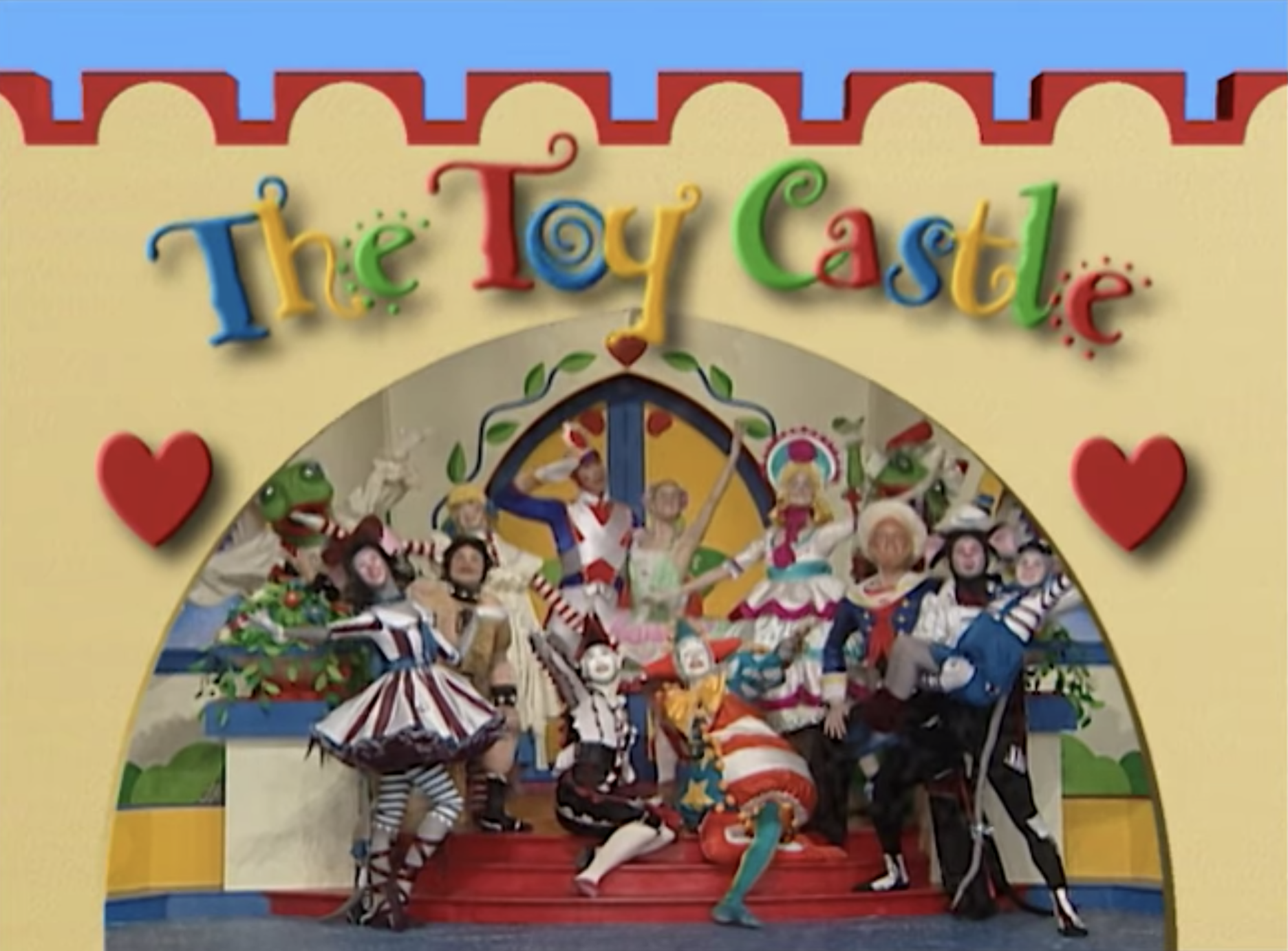
I watched it every morning before school. In fact, the part that’s been so funny about prepping for this call is, I may have actually continued to watch it before school into middle school. Which obviously would have overlapped with me being your student. I’ve spoken to two friends in the last week ahead of this call, and mentioned that you’d played a big role in creating that show, and they’d both watched it. As a kid, I used to get so scared that they weren’t going to freeze in time. [The Toy Castle follows the adventures of a bunch of toys—a ballerina, a soldier, a rag doll, etc.—while their owners, a little girl and a little boy, are asleep. Each episode begins with the two kids tucking themselves in, at which point their toys come alive, and ends with them starting to wake up, at which point the toys freeze.] You unlocked a memory for me there.
That was a wonderful experience, we did three seasons of it. But because it was targeting three- to five-year-old kids, once the three seasons were in the can… I’m now actually realizing that a lot of it has to do with why I even ever met you… we did three seasons of that show, but then they had a syndication package, so they didn’t need any more. Because by the time they get to the end of season three, there’s a whole new generation of three-year-olds sitting there, whose parents are looking for TV content for them.
And I’d been doing most of my professional career in Europe, but I came back for a festival, and my parents were getting old, and my knees were shot, and it was time to come back to Canada. I went to university, and when I got out of university, I got this gig doing Toy Castle, and what a great gig, did that for three years. And then thought, Okay, I’m a Canadian TV choreographer and writer now. I’m gonna sit right here by the phone and get jobs. You can see where this is going.
A year later, there are cobwebs between me and the phone, it had not rung. And I suddenly realized, Holy cow, I need a job. I ran out and got the Globe and Mail, which is what you did in those days, flipped it open, and I’m looking at a full-page ad for a school I’d never heard of before. And they wanted a dance/drama teacher, and I thought, I can fake my way through that. I went in and…
And it worked out.
It worked out. Well actually, not really. When I first started, they’d been impressed by the fact that I’d been in the National Ballet company and all of this stuff, but I’d never been to teachers’ college. I had taught a lot because I’d assisted Molly and taught professional dance classes in Paris, in London, in Toronto. And I’d done that a lot, but I was always teaching people who were giving me their own money. But now I’m looking at a bunch of 11-, 12-year-old kids who basically want to know what song I’m playing next. I had no idea how to teach those kids, so it was rough at first.
But I was pretty pleased with that [Toy Castle] work, it was gratifying to do. And a lot of it had to do with this amazing showrunner, Nancy Trites-Botkin, who taught me a lot about writing and teaching. And I’m going to shamelessly boast to you, Sydney, because you have been listening to what I’ve been saying: I actually wrote and choreographed the episode that we won a Gemini for.
I was going to ask! I saw that the show at one point won a Gemini [now called a Genie], and was going to politely find a way to ask about it.
The producer wins it, but there’d be three little stories in a half-hour segment, and it was one seven-minute story that won the Gemini, and it was one I’d written. I choreographed them all. But I’d also staged all of them. The director was more of a technical gal, so the actual staging and on-set direction was me, and that was very satisfying, fulfilling work. I really liked that. But thank you for being interested in that! And you never know, maybe someday you’ll show a couple Toy Castle episodes to children of your own. ●
Some odd(itie)s and ends...
- I’ve long admired my friend Coleman Spilde’s ability to write about disappointing pop culture thoughtfully and from a place of love, but without mincing words. With that, he did an excellent job reviewing the new Kim Petras x Nicki Minaj collab
- Madonna has officially released Jonas Åkerlund’s director’s cut of the “American Life” video. It’s not quite the version that was pulled from broadcast—this one’s significantly more graphic (fair warning), with a pretty different ending from any of the ones Madonna was reported to be considering back in 2003—but I think it’s the most powerful one, and strongest on the point of war-as-entertainment (once again, here’s my Billboard retrospective on the video scandal)
- Like a lot of people, I’ve found the recent AI explosion weird and disorienting, and don’t know how to feel about so much of it. So I quite appreciated my friend Dan Simpson’s short and sweet video essay on why AI art isn’t actually art
- Go listen to the new Jessie Ware album! You won’t regret it!
Mononym Mythology is a music video culture newsletter by me, Sydney Urbanek, where I write about mostly pop stars and their visual antics.
I do that for free—and actually pay to use this platform—so if you happened to get something out of this instalment, you’re more than welcome to buy me a coffee.
The best way to support my work otherwise is by sharing it. Here’s where you can say hello (if you received this in your inbox, you can also reply directly to this email), here’s where you can subscribe, and I’m also on Twitter and Instagram.

